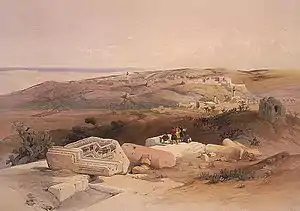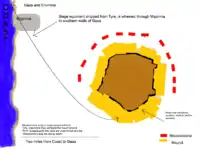Siege of Gaza
The Siege of Gaza was a military event in the Egyptian campaign of Alexander the Great in 332 BC.
| Siege of Gaza | |||||||||
|---|---|---|---|---|---|---|---|---|---|
| Part of Wars of Alexander the Great | |||||||||
 Painting of Gaza by David Roberts, in The Holy Land, Syria, Idumea, Arabia, Egypt, and Nubia | |||||||||
| |||||||||
| Belligerents | |||||||||
|
Hellenic League |
| ||||||||
| Commanders and leaders | |||||||||
|
Alexander the Great Hephaestion |
Batis (POW) | ||||||||
| Strength | |||||||||
| 45,000 | 15,000 [1] | ||||||||
| Casualties and losses | |||||||||
| Fewer than the Egyptians | 11,000[1] | ||||||||
 Gaza Location of the Siege of Gaza | |||||||||
During the Siege of Gaza, Alexander succeeded in reaching the walls by utilizing the engines he had employed against Tyre. After three unsuccessful assaults, the stronghold was taken by storm.[2]
Batis, the commander of the fortress of Gaza, expected to hold Egypt in subjection until the Persian Great King Darius III could raise another army and confront Alexander in a battle from this city.[3] The fortress was located on an eminence, on the edge of a desert from which the surrounding area could be easily controlled. It controlled the main road that went from the Persian province of Syria to Egypt. The city, over 60 feet (18 m) high, was traditionally employed to control the surrounding area, which even then was a hotbed of dissent.[3] Batis was aware that Alexander was marching down the coast, as he had just been victorious at Tyre. He therefore provisioned Gaza for a long siege.[3] It is likely that he was aware of Alexander's scheme of controlling the entire Mediterranean coast before moving to Persia proper.
Siege


Upon arriving, Alexander camped near the southern side of the city and deemed the southern walls as the weakest.[4] Near these weak points, Alexander built the mounds that were eventually used to enter the city.[4] It is alleged the mounds were built quickly, despite the engineers' belief they could not be completed due to the nature of Gaza's fortifications.[5]
One day during the siege, the Gazans made a sortie against enemy siege equipment constructed on site, and Alexander led his shield bearing guards into counterattack. Alexander's shoulder was injured in the attempt.[5] According to Arrian, the rest of the mound was completed shortly after, around the whole of Gaza.[5] At some undefined period after this, the siege equipment from Tyre arrived, and was put into use also. It was after this that major sections of the wall were broken by the Macedonians.[5] After three attempts to enter the city, the Macedonians finally entered the city. The Gazans fought bitterly.
Consequences of the siege
Batis, a eunuch,[6] refused to surrender to Alexander. When Gaza was taken, the male population was put to the sword and the women and children were sold into slavery.
According to the Roman historian Quintus Curtius Rufus,[7] Batis was killed by Alexander in imitation of Achilles' treatment of the fallen Hector. A rope was forced through Batis's ankles, probably between the ankle bone and the Achilles tendon, and Batis was dragged alive by chariot beneath the walls of the city. Alexander, who admired courage in his enemies and might have been inclined to show mercy to the brave Persian general, was infuriated at Batis's refusal to kneel and by the enemy commander's haughty silence and contemptuous manner.
As a result of the siege, Alexander was allowed to proceed south into Egypt securely, without his line of communications being threatened from the North by Batis from Gaza.
References
- D. W. Engels: Alexander the Great and the Logistics of the Macedonian Army, University of California Press, Berkeley and London, 1978, ISBN 0-520-04272-7, pp. 72f. (fn. 7)
- "Leaders and Battles: Gaza, Siege of". Leaders and Battles Database. Archived from the original on 2006-10-22. Retrieved 2007-01-18.
- Dodge, Theodore Ayrault (2008-11-07). Alexander - A History of the Origin and Growth of the Art of War from the Earliest Times to the Battle of Ipsus, B.C. 301, with a Detailed Account of the Campaigns of the Great Macedonian - Theodore Ayrault Dodge - Google eBookstore. Retrieved 2012-11-07.
- Dodge, Theodore Ayrault (2008-11-07). Alexander - A History of the Origin and Growth of the Art of War from the Earliest Times to the Battle of Ipsus, B.C. 301, with a Detailed Account of the Campaigns of the Great Macedonian - Theodore Ayrault Dodge - Google eBookstore. Retrieved 2012-11-07.
- Dodge, Theodore Ayrault (2008-11-07). Alexander - A History of the Origin and Growth of the Art of War from the Earliest Times to the Battle of Ipsus, B.C. 301, with a Detailed Account of the Campaigns of the Great Macedonian - Theodore Ayrault Dodge - Google eBookstore. Retrieved 2012-11-07.
- Aharoni, Yohanan (2006). The Jewish People: An Illustrated History. New York: Continuum. p. 57. ISBN 9780826418869.
- Quintus Curtius Rufus; Digby, John (tr); Freinsheim, Johann (fwd) (1747). History of the Wars of Alexander (v.II) (3rd ed.). London: A.Millar. p. 211.
External links
- Arrian; Chinnock, E.J. (tr) (1884). The Anabasis of Alexander II. London: Hodder and Stoughton. pp. 136–139.
